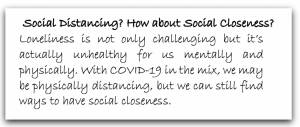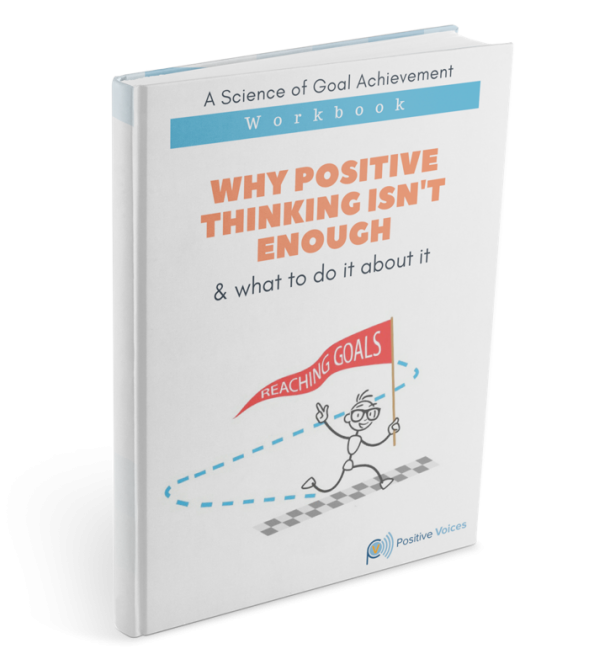
Long before the Novel Coronavirus outbreak, loneliness and isolation had been on my mind. The statistics are sobering: According to a survey commissioned by AARP, loneliness affects more than one-third of Americans. Additionally, feeling alone increases the risk of death by 26% (Holt-Lundstad & Smith, 2010). Loneliness is toxic. It’s not only is harmful to our state of mind and mood, but it’s downright dangerous for our health. Did you know that loneliness is more predictive of all-cause mortality than smoking or obesity?
Put COVID-19 in the mix and now the problem exacerbates. As many of us are holing up in our homes, we are reducing (and in some cases eliminating, should you live alone) a key aspect to our well-being: connecting with others. And if you are already feeling the impact, “Buckle up, Baby,” because we just got started.
There is Good News: You Have Some Control
The good news is that we can use our creativity and brainpower to find new and innovative ways to connect with others. It may not be a hug or huddle, but it can still help fill the void. And with added creativity, novelty brings its own reward. I encourage you to take a few minutes and consider these questions.
- What are your “normal” ongoing social connections in your life? Who do you see? How do you connect? Do you share a common interest? Do you emotionally support each other? Professionally connect? Try to capture some ideas around what you normally do to help you come up with some substitutes where you can.
- Who are the most important people in your life? How often do you want to connect with each? For example, I have people I connect with daily, and others to whom I purposely send a ping each quarter. Most of my circle falls somewhere in between.
- Are there important people in your life that you have lost track of or you are not spending the time to connect to? Who are they?
- Who might need you right now? Remember, looser ties such as an elderly neighbor might be someone to consider.
These ideas are meant to give you an idea of what you are aiming for. If you know what you want and where you are aiming, you can create alternatives for staying connected. I suggest you now spend a few minutes and come up with a connection plan. Be creative! For example, I am reaching out to a group of like-minded women and we are going to take turns sharing our expertise each week over Zoom. We have a communication expert, a life coach, a health enthusiast, and more that are going to try their hand at it. It will not be like a professional webinar because this is a group of buddies sharing. I am really looking forward to it!
If you are so inclined, I encourage you to consider scheduling things ahead. If you are like me, if it’s not on my calendar, it might just evaporate as a thought never explored. While we will certainly miss the person-to-person contact, there are things we can do. Feeling low on ideas? Read on.
Connect with Those you Live With
If we are lucky enough to be with others, we can focus on deepening those connections. It’s a great chance to try to learn something new about them. Be curious! We can also really connect by discussing our fears and concerns. Upgrade those conversations.
Mealtime is also a great time to relate with others. If your family or roommates don’t sit down for meals, it just might be the right time to start that tradition – and do it tech-free. Boost it by sharing things you are grateful for or ask a question and listen as everyone shares their answers.
Other things we can do at home with others include exploring things together we have long wanted to learn such as cooking a new cuisine, studying a new language, enjoying game night, exercising together, holding a dance party, doing crafts…the list goes on.
Connect Virtually
 Technology certainly opens up a lot of new possibilities. There are all the obvious things we can do like social media, online gaming, texting, and online forums. These are great. When interacting on social platforms, we can share our frustration and fear, but we can also focus on adding some lightness to those around us with our humor and optimism by sharing the details of a funny moment, something sweet that happened, or offering up a gratitude.
Technology certainly opens up a lot of new possibilities. There are all the obvious things we can do like social media, online gaming, texting, and online forums. These are great. When interacting on social platforms, we can share our frustration and fear, but we can also focus on adding some lightness to those around us with our humor and optimism by sharing the details of a funny moment, something sweet that happened, or offering up a gratitude.
Meeting platforms like Zoom allow us to meet as a group or 1:1. This isn’t just good for business but can help us connect socially. Things you can try include an online book club, temporarily moving hobbies and clubs online, taking a virtual trip together to the museum or national park, watching a movie together (check out Netflix’s new app), or enjoying a virtual coffee or glass of wine (you each grab your beverage and lazily sit down to just chat). If you are working remotely and miss the interaction, I know some groups that open up a technology channel such as Zoom, GoToMeeting, or Slack just so that they can have a virtual “water cooler” available for casual chat.
Be Kind
One of the best ways we can connect to others is through acts of kindness. Research shows that it’s good for the giver and the receiver (check out this article on several science-backed how). Both parties are elevated by the experience. We can mail a greeting card, letter, or a gift card. We can send groceries to an elderly neighbor or shut-in. We can offer our assistance when we see someone struggle or offer a kind word when we notice another’s strengths.
We hope that was helpful in creating a plan for connecting with others. You have an idea to share? On Facebook, Instagram or Twitter, use the hashtag #togetherwhileapart.
Sources:
Anderson, G. (Ed.). (2010). Loneliness among Older Adults: A National Survey of Adults 45 . AARP Magazine. Retrieved from https://assets.aarp.org/rgcenter/general/loneliness_2010.pdf
Holt-Lunstad, J., & Smith, T. (2010). Social Relationships and Mortality Risk: A Meta-analytic Review. SciVee. doi: 10.4016/19911.01


Danke fuer die Info